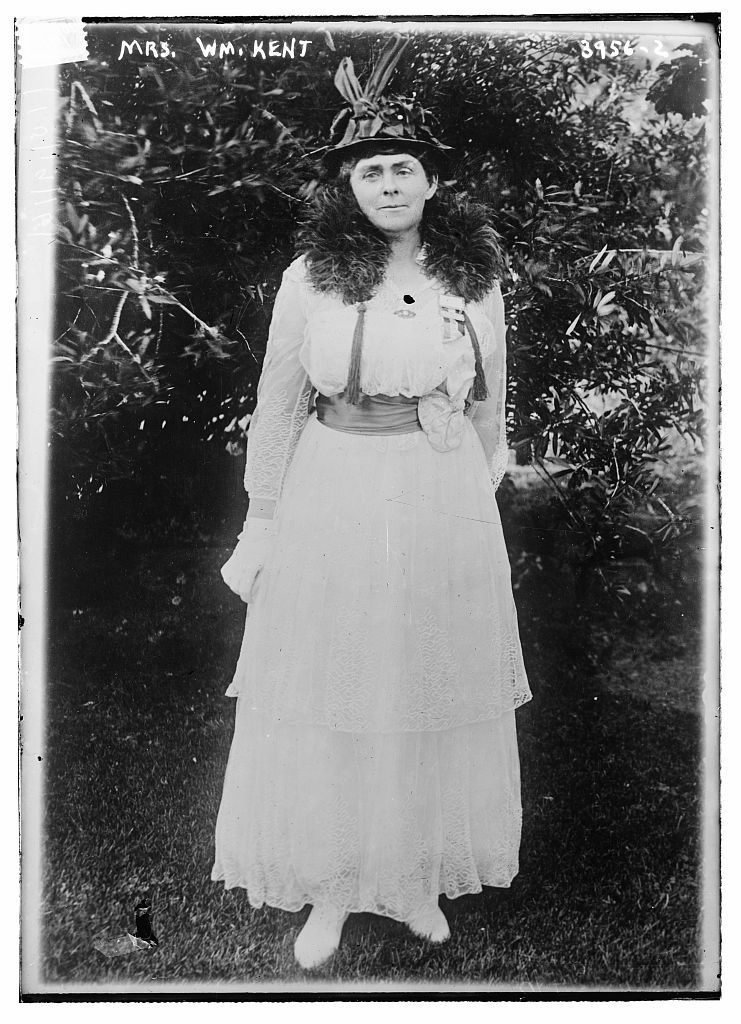the john muir exhibit - people - elizabeth baldwin thacher kent
Elizabeth Baldwin Thacher Kent
1868-1952

- Elizabeth Baldwin (Thacher) Kent, the wife of congresman William Kent was the daughter of Elizabeth Baldwin (Sherman) and Yale Professor Thomas Anthony Thacher. As a descendent of two venerable American families, it is said that William Kent owed his entire political career (1911-1917) to his wife and mother-in-law. Elizabeth's mother was granddaughter of American founding father Roger Sherman of Connecticut and his wife Rebecca Minot (Prescott) Sherman. Five of her aunts had given birth to a panoply of prominent American politicians, ranging from U.S. Senators to U.S. Attorney Generals, a U.S. Secretary of State, a U.S. Surveyor General for California, plus a Connecticut State Governor and Massachusetts Chief Justice.
- Together the couple had seven children. Elizabeth and Muir corresponded directly, and she wrote to Muir in 1909, telling him how she had read "your delightful story of Stickeen" to her children and thanked him for sending her copies of some of his books.
- When the coastal redwood forest in Marin was to be cut down for a water reservoir, the couple purchased 611 acres (the deed was in both their names) and donated 295 acres to the federal government. In 1908, President Theodore Roosevelt declared the donated land Muir Woods National Monument. Roosevelt had suggested naming the area after Kent, but the Kents requested that it be named for conservationist John Muir. These woods became the Muir
Woods National Monument.
- Elizabeth was active in women's rights and worked for getting women suffrage. Elizabeth emphasized the hard work of organizing to win the right to vote. She wrote: "It took courage in those days to speak on suffrage at every gathering where opportunity offered; to distribute literature at public meetings and clubs; on trains and streetcars; to put up posters; to speak from automobiles in little towns; to wear suffrage badges and to engage in conversation on the subject with friend or stranger wherever that timely word would count." California women won the right to vote in 1911, almost a decade before the federal amendment was passed.
- After that victory, Elizabeth moved to Washington, D.C. with her children to join her husband who was in Congress - - and brought her suffrage advocacy to the national stage. Elizabeth lobbied members of Congress, testified twice before congressional committees, and campaigned around the country-- from Chicago to Oregon -- marching in demonstrations and giving speeches at rallies.
- She was a featured speaker at the 1913 and 1914 the National American Women's Suffrage Association (NAWSA) conventions. Elizabeth became a member of their Congressional Committee. Elizabeth helped form the Congressional Union (later renamed the Women's Party). Working with Alica Paul, Elizabeth was involved in picketing the White House in support of suffrage. She was arrested twice -- and her husband, who was ironically campaigning for President Wilson's re-election, paid her bail. As Elizabeth wrote, "However little he liked to have his wife take the political stand that she did, and he certainly did not like it at all, he could never ask her to depart from her own convictions."
- After the ratification of the Nineteenth Amendment, and William's defeat in the 1920 election for U.S. Senate, Elizabeth became involved with the Women's International League for Peace and Freedom. In 1937, she became president of the Marin County chapter. In 1945, Elizabeth participated in the meeting of the United Nations in San Francisco.
- As the National Park Service notes: "One of the reasons we know a lot more about her husband William - - aside from the obvious male bias of history from that era -- is that, as the family historian, Elizabeth compiled her William's papers and wrote a several hundred page biography of her husband. Her own autobiography merits less than two dozen pages. Yet Elizabeth was a visionary activist in her own right, becoming a leader in both the California and the national suffrage movements."
- For more information, see Elizabeth Thacher Kent: Suffragist, Jailbird and Biographer by National Park Service (off-site link)
Home
| Alphabetical Index
| What's New & About this Site